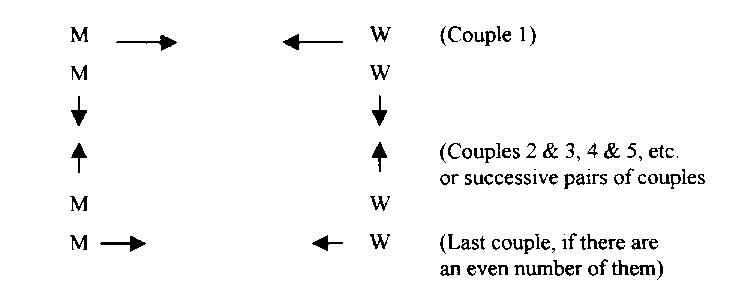[ This article appeared in volume 3 of the Letter of Dance. ]
To the patrons of the Letter of Dance, greetings from Baroness Jessa d'Avondale:
While re-reading back issues of the Letter of Dance, I noticed that Henry of Maldon had posed the question of what Playford means by the term "double Hey" (as opposed to the "single Hey"). Quite coincidentally, I had the same question several months ago. Here is what I found.
The Single Hey appears to refer to a hey done by the men/women on their side of the set only. It can be done simultaneously (as in Beggar Boy), or by one side at a time (Black Nag). Even in the case where the first couple changes places before beginning the hey (Grimstock), the rest of the men and women do not leave their own line.
The Double Hey is a rarer figure, appearing in "The Old Mole" and "Goddesses", dances not common to the SCA. In "The Playford Ball", a collection of dance reconstructions by the Country Dance and Song Society, the Double Hey for 3 couples is described as a "circular hey for 6":
The 1st couple faces each other, the 2nd couple faces the 3rd (who face up). All begin the hey by passing right shoulders, and continue around the set back to their places.
Baron Gerhard Kendall of An Tir informs me [via Elizabeth Braidwood] that when they do the double hey with four couples, the 4th couple faces each other and heys around the set, mirroring the 1st couple.
So, it appears that for any number of couples, the initial direction of movement is:

Old Mole is a dance for a set number of couples (3), so everyone knows which direction they will have to move when the hey starts. In Goddesses, for as many as will, this would have to be figured out before the dance begins, perhaps by having couples take "hands four" from the second couple on down.
If anyone has more information on this figure, I would be pleased to hear from them.
Jessa
[Marla Lecin, 362 Cherry Avenue,
New Jersey, 08805]
Webbed by Gregory Blount of Isenfir (Greg Lindahl) (lindahl@pbm.com)